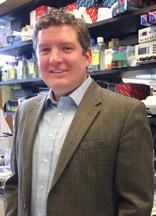Areas of Interest
The Parker laboratory uses an integrative research approach in the general fields of computational biology and functional genomics. The major goal of the lab is to generate mechanistic knowledge about how disease susceptibility is encoded in the non-coding portion of the genome, with a focus on type 2 diabetes. We accomplish this through an interdisciplinary combination of molecular/cellular and computational approaches. Specifically, we generate multiple high-throughput data sets on the genome, epigenome, transcriptome, and proteome across species and in disease-relevant tissues/cells and use computational approaches to integrate and analyze this data. Looking forward, our belief is that these high-throughput biological profiling and analysis approaches will be closely tied to disease diagnosis, prognosis, and treatment—and will therefore have a tremendous influence on medicine.
Honors & Awards
Distinguished Postbac Mentor Award, NIH (2014)
Trainee of the Year Award, NIH/NHGRI (2013)
Fellows Award for Research Excellence (FARE), NIH (2013)
American Diabetes Association Pathway to Stop Diabetes Award (2013)
NIH Pathway to Independence Award (2013
Pharmacology Research Associate (PRAT) Program Fellow, NIH/NIGMS (2011-2014)
Genome Technology Young Investigators of the Year Award (2010)
Boston University Bioinformatics Innovative Teaching Award (2009)
Genome Research Best Poster Award (Biology of Genomes Meeting, 2007)
Boston University Presidential Fellowship (2004)
Credentials
- 2011-2014 Pharmacology Research Associate Program Fellow, NIGMS/NIH
- 2009-2011 Postdoctoral Fellow, NHGRI/NIH
- 2004-2009 Ph.D., Bioinformatics and Systems Biology, Boston University
- 1998-2000 M.S., Molecular Biology, East Carolina University
- 1994-1998 B.S., Biology, East Carolina University
Published Articles or Reviews
“The genetic regulatory signature of type 2 diabetes in human skeletal muscle” L.J. Scott*, M.R. Erdos*, J.R. Huyghe*, R.P. Welch*, A.T. Beck, B.N. Wolford, P.S. Chines, J.P. Didion, N. Narisu, H.M. Stringham, D.L. Taylor, A.U. Jackson, S. Vadlamudi, L.L. Bonnycastle, L. Kinnunen, J. Saramies, J. Sundvall, R. Albanus, A. Kiseleva, J. Hensley, G. Crawford, H. Jiang, X. Wen, R.M. Watanabe, T.A. Lakka, K.L. Mohlke, M. Laakso, J. Tuomilehto, H.A. Koistinen, M. Boehnke*, F.S. Collins*, S.C.J. Parker* Nature Communications (2016) [* equal contributor]
“The genetic architecture of type 2 diabetes” Christian Fuchsberger*, Jason Flannick*, Tanya M Teslovich*, Anubha Mahajan*, Vineeta Agarwala*, Kyle J Gaulton*, et al. Nature (2016) [* equal contributor]
“Super Enhancers in cancers, complex disease, and developmental disorders.” A. R.
Niederriter, A. Varshney, S. C. J. Parker, and D. M. Martin. Genes (2015)
D.X. Quang, M.R. Erdos, S.C.J Parker*#, F.S, Collins*. “Motif signatures in stretch enhancers are enriched for disease-associated genetic variants”. Epigenetics & Chromatin (2015) [* equal contribution; # corresponding author]
G. Vahedi, Y. Kanno, Y. Furumoto, K. Jiang, S.C.J. Parker, M.R. Erdos, et al. “Super-enhancers delineate disease-associated regulatory nodes in T cells.” Nature (2015)
The modENCODE Project Consortium*. “Comparative analysis of metazoan chromatin architecture.” Nature (2014) [* lead analyst]
S. C. J. Parker*, M. L. Stitzel*, D. L. Taylor, J. M. Orozco, M. R. Erdos, J. A. Akiyama, K. Lammerts van Bueren, P. S. Chines, N. Narisu, NISC Comparative Sequencing Program, B. L. Black, A. Visel, L. A. Pennacchio, F. S. Collins. “Chromatin stretch enhancer states drive cell-speci c gene regulation and harbor human disease risk variants.” PNAS (2013) [* co rst author]
J. J. Gartner*, S. C. J. Parker*, T. D. Prickett., K. Dutton-Regester., M. L. Stitzel, J. C. Lin, V. L. Simhadri, S. Jha., N. Katagiri, V. Gotea, J. K. Teer, X. Wei, M. A. Morken, U. K. Bhanot, NISC Comparative Sequencing Program, G. Chen,, L. Elnitski, M. A. Davies, J. E. Gershenwald, H. Carter, R. Karchin, W. Robinson, S. Robinson, S. A. Rosenberg, F. S. Collins, A. A. Komar, C. Kimchi-Sarfaty., N. K. Hayward, E. H. Margulies, Y. Samuels. “Whole-genome sequencing identi es a recurrent functional synonymous mutation in melanoma.” PNAS (2013) [* co rst author]
The ENCODE Project Consortium*. “An Integrated Encyclopedia of DNA Elements in the Human Genome.” Nature (2012) [* lead analyst]
S. C. J. Parker, J. Gartner, I. Cardenas-Navia, X. Wei, H. Ozel Abaan, S. S. Ajay, N. F. Hansen, L. Song, U. K. Bhanot, J. K. Killian, Y. Gindin, R. Walker, P. S. Meltzer, J. C. Mullikin, T. S. Furey, G. E. Crawford, S. A. Rosenberg, Y. Samuels, and E. H. Margulies. “Mutational signatures of de-differentiation in functional non-coding regions of melanoma genomes.” PLoS Genetics 8(8) (2012)
S. C. J. Parker and T. D. Tullius. Current Opinion in Structural Biology. “ DNA shape, genetic codes, and evolution.” Advanced online publication (2011)
S. C. J. Parker, L. Hansen, H. Ozel Abaan, T. D. Tullius, and E. H. Margulies. “Local DNA Topography Correlates with Functional Non- coding Regions of the Human Genome.” Science 324:389-392 (2009)
International Human Genome Sequencing Consortium. “Finishing the euchromatic sequence of the human genome.” Nature 431:931-45 (2004)

